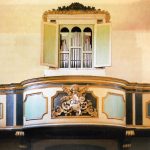The panel, originally housed in Santa Maria in Valle, depicts the Madonna in Majesty with the Child (113 x 41 cm). It features a halo that is shaped and slightly protruding. The canvas, following the customary technique of applying paint to wood, retains only fragmentary traces of color. Its condition is quite poor, as the lower part is almost completely lost, as well as the face of the Child, whose eyes, nose, and upper lip can still be made out, while the oval of the face and the halo—perhaps not gilded but with silver leaf—have been completely erased. There are also noticeable burn marks on the right side, caused by candles that were lit in front of the sacred image.
The Virgin wears a blue mantle lined with red, covering her head and cascading over her shoulders with rich, somewhat rigid folds, though still with a distinctly Gothic quality in the looseness of the design. The Child’s garment appears to have been brown with white highlights, visible in the remaining color fragments.
This work is attributed to the circle of Margarito d’Arezzo (documented from 1250 to 1262) and is datable around 1260-1262. It is very close in style to the Madonna in Majesty with Child and Saints, housed in the Museo Statale d’Arte Medievale e Moderna in Arezzo, which comes from Terranova Bracciolini.
The provincial aspect of the image may appear as a vernacular imitation of Byzantine-style art; however, it retains a genuine freshness that places it among works of undoubted interest. According to tradition, at an unspecified time, the panel was said to have been found underground by some farmers and placed in various churches, including the one at the Castle of Montozzi (Pergine), but each time it was miraculously rediscovered at its original location. This miraculous event supposedly sparked great popular devotion to the sacred icon and the construction of a sanctuary at the site.
However, this legend lacks historical basis, as the church of Santa Maria in Valle already existed in the 13th century. The site, due to its location, must have been sacred since ancient times, and the Virgin Mary took on various identities of deities connected to the earth, such as Ceres, the goddess of the harvest, and to the waters, like the nymphs of springs and other supernatural female beings. These sacred presences symbolically emphasized the fertilizing power of the chthonic (underground) deities, manifested as waters from the “depths” rising from below the earth, just as the Virgin, according to legend, emerged from the earth. Moreover, rural populations, throughout the 13th century, needed to rely on the protection of Mary to escape the raids of the Florentine and Aretine armies.
In 1974, part of the panel was stolen: the head of the Madonna was separated from the rest of the artwork and taken. However, it was quickly recovered, and after restoration, it was relocated to a safer place. Today, it is carefully preserved in the Propositura of Laterina.
On the choir loft of the sanctuary stands a small positive organ (a medium-sized instrument that can be moved from place to place but must be placed on a stand), of anonymous authorship, dating back to the 17th century, but with older pipes and additions from 1714, as indicated in the secret inscription that also bore the name of the maker, now lost. Likely commissioned during the building campaign promoted by the Busatti family, the instrument has a 45-key keyboard (C1 to C5) with a short octave. The pedalboard has 8 pedals (C1 to B1); the stops are four: Principale (4′), Ottava, Duodecima, and Decima-quinta; the tracker action is employed for the action of the pipes. The case, dating from the early 18th century, features two lateral Tuscan columns and a simple cornice, topped by a crest carved in wood with vine tendrils and grape clusters, at the center of which is a bishop’s coat of arms.
Licia Bertani





